- News
- Reviews
- Bikes
- Accessories
- Accessories - misc
- Computer mounts
- Bags
- Bar ends
- Bike bags & cases
- Bottle cages
- Bottles
- Cameras
- Car racks
- Child seats
- Computers
- Glasses
- GPS units
- Helmets
- Lights - front
- Lights - rear
- Lights - sets
- Locks
- Mirrors
- Mudguards
- Racks
- Pumps & CO2 inflators
- Puncture kits
- Reflectives
- Smart watches
- Stands and racks
- Trailers
- Clothing
- Components
- Bar tape & grips
- Bottom brackets
- Brake & gear cables
- Brake & STI levers
- Brake pads & spares
- Brakes
- Cassettes & freewheels
- Chains
- Chainsets & chainrings
- Derailleurs - front
- Derailleurs - rear
- Forks
- Gear levers & shifters
- Groupsets
- Handlebars & extensions
- Headsets
- Hubs
- Inner tubes
- Pedals
- Quick releases & skewers
- Saddles
- Seatposts
- Stems
- Wheels
- Tyres
- Health, fitness and nutrition
- Tools and workshop
- Miscellaneous
- Tubeless valves
- Buyers Guides
- Features
- Forum
- Recommends
- Podcast
feature
1x vs 2x: Are single chainring set-ups the future of road cycling or just another marketing fad?
After a difficult few years, punctuated by the lukewarm response to 3T’s brief assault on the pro peloton in the late 2010s, 1x drivetrains have become increasingly popular on road bikes in recent times, buoyed by their appearance at this year’s Tour de France and world championships on the bikes of Jumbo-Visma riders like two-time yellow jersey winner Jonas Vingegaard.
But are we witnessing another disc brake-esque revolution in bike technology and how the humble road bike is traditionally set up? To find out, we’ve been putting in the miles comparing single and double chainring setups, in order to find out whether the ever-divisive 1x really is a viable alternative for gain-seeking, road-going amateurs...
> Jonas Vingegaard uses 1x gearing for Tour de France opening stages
After watching defending champion Vingegaard opt for a 1x groupset during the opening phase of the Tour de France and just about all his Jumbo Visma teammates use one at this year’s world championships in Glasgow, you might be wondering if single chainrings do indeed represent the future of road cycling.
After all, new tech does tend to trickle down from the upper echelons, while the technology has proved very successful on gravel and mountain bikes (and this wouldn’t be the first time we’ve nicked tech from our muddy counterparts, of course).
So, to find out once and for all if 1x is finally at a point where it’s a genuine competitor to the trusty double, I’ve switched my own bike, a Specialized Allez Sprint (below), over to a single chainring setup as part of a head-to-head road test that will put both systems through their paces, and determine the advantages, disadvantages, and important things to consider if you’re feeling swayed by the 1x revolution.
The advantages of 1x on the road
As we've mentioned many times before in previous articles, a 1x setup does bring plenty of plus points, especially to pro teams looking for every marginal gain (apologies).
And according to JP McCarthy, product manager at Sram, one of the main players in the 1x road market, there are four main benefits from swapping the traditional 2x for a single chainring set-up.
“First is the weight, as you eliminate the small chainring and the front derailleur, but it also depends on the size of the cassette,” McCarthy tells us.
“There is also a difference whether it’s a classics or a climbing day. On a classics day, if you combine a single chainring with a cassette that is wide enough to handle the day’s challenges, then you have a much more efficient shifting system, as there is no front shift.
“On a climbing day, you will have better efficiency as you’re using a bigger ring and a bigger cog size [more on that in a minute], which requires less chain articulation and results in some minor efficiency gains.”
The third main benefit, McCarthy says, is the aerodynamic advantage derived from removing the front derailleur and only having one chainring, while he also notes that chain retention is “better on 1x than 2x”.
McCarthy goes on to explain that other features that might appeal are the fact that a 1x system allows “less cross chaining at the extremes”, due to the single chainring being in the centre of where the inner and outer rings would sit, resulting in “simpler shifting” – “eliminating front shifts is a pleasure,” he says – and better aesthetics for the style-conscious among us.
The drawbacks
Clearly, if there were no disadvantages to using a single chainring on the road then this wouldn’t even be a debate, would it, so here’s a quick run-through of what we see as the main drawbacks:
For a start, you have fewer gears: typically 12 on the latest road bike, compared to 24 on a double-ring setup. Though as we’ll discuss in a minute, this might not be quite as bad as it sounds.
Bigger jumps between gears: To get the required range of gears to make it over steep climbs you generally need a larger cassette. This means you’ll have to put up with bigger gaps between each gear as you have fewer sprockets to satisfy the same range.
The weight saving isn’t exactly huge: We’ve done the maths on the Sram Red AXS setup that I’m running on my Allez, which saw 165g saved by ditching the front mech, while the 48T aero chainring is also 24g lighter than the Red AXS double setup.
However, on my set-up I also had to add 31g for the Wolftooth Aero chain guide and then an additional 35g for the difference between the Force AXS 10/33T I would normally run and 10/36T cassette required for the desired range on 1x. That results in a measly weight saving of just 123g – and the difference would be even less if I was using a Sram Red 10/33T cassette. (Sram doesn’t currently make a Red-level 10/36T).
And when asked about the potential aero saving Sram told us that the jury’s still out, despite the perceived aero gains from removing the front derailleur.
“We have data that indicates distinct advantages when the front derailleur and front derailleur hanger are removed. But quoting such data would be disingenuous,” they say.
“There’s far too much variation in that area of the bike to state any numbers with confidence. Although there’s an aero advantage to removing the FD, we encourage those who stand to gain the most from 1x performance advantages (i.e. professionals) to use a chain guide, which negates most of the aero benefits.”
1x vs 2x
With plenty of advantages and disadvantages then, what this debate really needs is a good old-fashioned road test – and that’s exactly what it got!
To help me out, my mate Tom, a firm 1x sceptic, brought along his matching Allez Sprint (he copied me) equipped with a far more conventional Shimano Ultegra semi-compact double-ring setup.
In his words (which may or may not have been spoken from a platform framed by cascading 1980s bike componentry): “It was time to put a stop to this nonsense – road bikes should have two chainrings. It gives you a greater range of gears, it means there are smaller gaps in between the gears and oh wait, it’s worked perfectly fine for, well I don’t actually know how long, but a really long time.”
Meanwhile, as the final few strains of the national anthem faded into the breeze, all I was hearing was that he was stuck in the past and probably still thinks that downtube shifters are the pinnacle of cycling technology.
Could I convince this steadfast traditionalist that 1x is a very real prospect for road riding in 2023?
To make him slightly happier about the world moving on, I let Tom choose the route, and predictably it was hilly. But little did he know that I was well-equipped to cope with both the inclines and descents.
In fact, I soon managed to quash the misconception that I had any less range of gears – my 1x groupset actually had a greater range than his Ultegra, which was set up with a fairly typical 52/36 front chainring and 11-28T cassette. Oh, and here’s the maths to prove it...
The numbers in the red boxes represent the gears that I have on my 1x groupset and the ratios in pink are the ones that Tom does. The difference between my largest and smallest gear, or in other words, the range, is 3.47, ever so slightly higher than the range of 3.44 of this particular double chainring setup.
I’m confident that, with Sram’s introduction of the 10T cassette sprocket, it is possible to get the required range on a 1x setup, no matter the terrain.
With a smallest gear ratio of 1.29, compared to my 1.33, Tom did have an ever so slightly higher cadence on the really steep stuff. However, on the descents I had the edge with a gear ratio closer to a 53/11 rather than 52/11. For day-to-day riding, I’d probably change my setup to a 46T ring at the front as it’s rare that I’m in a position of needing to pedal at 60kph+ when not racing.
You might have noticed that there are a lot more numbers with pink boxes around them than red, and this was the basis for Tom’s next argument, having been thwarted on the descents and hills.
Tom’s double chainring R8070 Di2 groupset is equipped with 22 gears – a full 10 more than mine. That difference would be even larger if he was on the latest Di2 or Sram AXS groupset, but I was confident that he had less usable gears than he thought… let me explain!
Once again, looking at the table above you will notice that there’s a serious overlap between the ratios provided by the two chainrings. Yes, there are 22 unique ratios but how many of them are legitimately useful? For example, I can’t think of many people who actively ride around in the 36/11 – in fact, on most Di2 groupsets it’s impossible to select the smallest few sprockets when in the little ring.
A little overlap between big and little rings is useful, as it means you’re not constantly switching between the two chainrings, but the maximum number of upward shifts (selecting a harder gear each time) on Tom’s typical 2x groupset is 17.
Where do we go from here?
After a solid month or so of riding with the 1x groupset, I think I’ve managed to convince even traditionalist Tom that it is a viable option for most road rides.
But, to paraphrase a journalist from an entirely different industry, have I seen cycling’s future, and is it 1x?
Well, personally, I think that single chainring set-ups will become a lot more popular on the road, but I don’t think they’re going to emulate the phenomenon we saw with disc brakes, where the old, seemingly unshakeable tech was almost completely replaced in just a few years.
I’m confident that you will continue to be able to purchase 2x for the foreseeable future, if that better suits your riding.
Posing the same question regarding possible 1x world domination to Sram, who have made no secret of the fact that they’re big fans of the single chainring, product manager McCarthy told us: “In its current forms, I reckon we’ll see a modest increase of 1x usage on pavement for WorldTour (and those who aspire to the WorldTour) for specific cases, such as time trials, uphill time trials, relatively flat races. WorldTour teams have found advantages in a wide range of 1x setups to meet and exceed their performance needs. We expect to see more.
“More toward the middle of the consumer market, we anticipate seeing more ‘endurance/all-road/all-rounder’ bikes spec’ed with 1x as Original Equipment.”
However, he also noted that “we certainly don’t see 1x eclipsing 2x on road bikes, but 1x is increasingly popular amongst road riders for a wide range of reasons, from course-specific performance advantages to simpler shifting to aesthetics.”
After using 1x for several hundred miles now, I’m sold on its benefits. For general riding I love the simplicity and the range is more than enough – in fact, it matches the 2x setup that I was running previously.
Me and Tom are pretty keen riders but I also think that 1x a sensible option for cyclists who ride less regularly. For example, the other day my mum borrowed a bike with 1x on it and asked why all bikes aren’t like this. My mum, bless her, is someone who is yet to understand that a bike is not meant to rattle or squeak and when it does you should probably change gear and not cross-chain (okay, there's a debate to be had on whether cross-chaining is definitively a bad thing, but that's for another feature).
Either way, with 1x it is quite literally impossible to cross-chain, and in this situation we’re told it is actually more efficient.
In my opinion, there are clear benefits to a single chainring whether you’re a professional racer, keen amateur, or a less experienced cyclist.
> Review: Vielo R+1 Alto SRAM Force e-Tap AXS
However, I did have one more question for Sram: Would my drivetrain wear faster when using a single chainring?
McCarthy says there’s “no difference between 1x and 2x chain and cassette wear”, though he was unable to give a mileage figure because “debris is a greater contributor to chain wear than miles” (just another reminder for me to clean my chain when I get home!).
The jumps between the gears are a little bit larger and that is undeniably a disadvantage. On most rides I didn’t find this an issue and could find a natural and comfortable cadence.
However, if I raced on this bike, then I would definitely opt for a smaller cassette to close up those gaps at the expense of some range.
This is something that Jumbo-Visma, who have been using the 1x system over the last year, know all too well.
When pressed on the matter, the Dutch team told us: “In the world of professional cycling, every small adjustment can be crucial for performance. We recently decided to switch to a 1x setup, a decision driven by multiple considerations.
“First, there’s the aerodynamic advantage. By removing the front derailleur (FD) and using an aero 1x chainring, our bike cuts through the wind more efficiently. Then there’s the weight advantage. Eliminating the FD and the double chainring means less weight to carry, which is always a bonus, especially on climbs.”
“But it’s not just about what we remove, it’s also about what we add,” they continued. “By opting for a larger cassette at the rear, we can fit a chainring that’s big enough for flat terrain and yet small enough to be effective on climbs. This approach means we often ride in a ‘big-big’ gear setting, which is more efficient than the ‘small-small’ combination."
“Of course, with the 1x setup, we have fewer gear choices. But in practice, if the available gears are well-matched to the rider’s needs, the limited options are rarely missed.
“And let’s not forget reliability. Sram’s FDs are top-notch, but in a sport where every second and every risk counts, reducing the chance of mechanical problems by having fewer components is a tactical move. In essence, by choosing a 1x setup, we optimize our performance by improving efficiency, weight, and reliability – key factors in the race for success.”
Final Thoughts
> Should you run a 1x set-up on your road bike?
Whether you’re a pro, an amateur, or a beginner, we reckon that over the coming years, there’ll be more and more bikes shipping with 1x groupsets. However, unlike with the transition to disc brakes – where there’s now a seriously limited selection of new rim brake bikes – we think that 2x will remain an option for a good while yet.
And that is the perfect scenario really, because what’s better than having choice? Even Tom will find it hard to deny that there’s not a time and place for single chainrings, and unlike previous 1x efforts (AquaBlue we’re looking at you) we are now at a point where it’s a very real option for road bikes.
In reality, 1x is not a perfect solution to road bike gearing, but then neither is 2x. On that setup, you’re lugging around six or so gears which aren’t even useful to you – and at least with 1x every gear on the cassette is useful!
Let us know in the comments section below whether you’re intrigued to make the switch on your next bike...
Jamie has been riding bikes since a tender age but really caught the bug for racing and reviewing whilst studying towards a master's in Mechanical engineering at Swansea University. Having graduated, he decided he really quite liked working with bikes and is now a full-time addition to the road.cc team. When not writing about tech news or working on the Youtube channel, you can still find him racing local crits trying to cling on to his cat 2 licence...and missing every break going...
Latest Comments
- johnsonmoog 2 hours 9 min ago
So, if Jamie needs 1000mg of sodium an hour, how many hydration tabs or elctrolyte mix does he need. I see SIS a hydration tab provides 798mg of...
- S.E. 2 hours 20 min ago
My guess is that they sell mainly on the German market - feel free to correct me. That might explain why they are not "pushing" their products,...
- ktache 2 hours 45 min ago
Now Emily Chappell really liked the Lezyne , I have the HV version, good, but I find the handle uncomfortable in use. I've often wondered about the...
- biking59boomer 1 hour 52 min ago
What about this one!? Taken in Cardiff Civic Centre 1939
- Muddy Ford 2 hours 55 min ago
Charlie Alliston got 18mths and is the reference case (because there are so few cases) for all campaigns by anti-cyclists that 'cyclists are not...
- belugabob 3 hours 56 min ago
My local football practice pitches (all weather, in a fenced off area, are regularly the scene of inconsiderate parking, with vehicles blocking the...
- chrisonabike 4 hours 14 min ago
Don't forget though "Englishman's home is his castle" - which includes my rights to grow a giant curtain wall of Leylandii to "protect my privacy"....
- Spangly Shiny 4 hours 21 min ago
Assos ASOS anyone?
- chrisonabike 4 hours 35 min ago
Replace them all with Bromptons and they'd take up zero space within days or even hours, as they are all relocated elsewhere. To eBay or possibly...
- Andrewbanshee 5 hours 6 min ago
Where I live we are experiencing a lot of housing development on small and large plots of land. These developers don't seem to have problems...

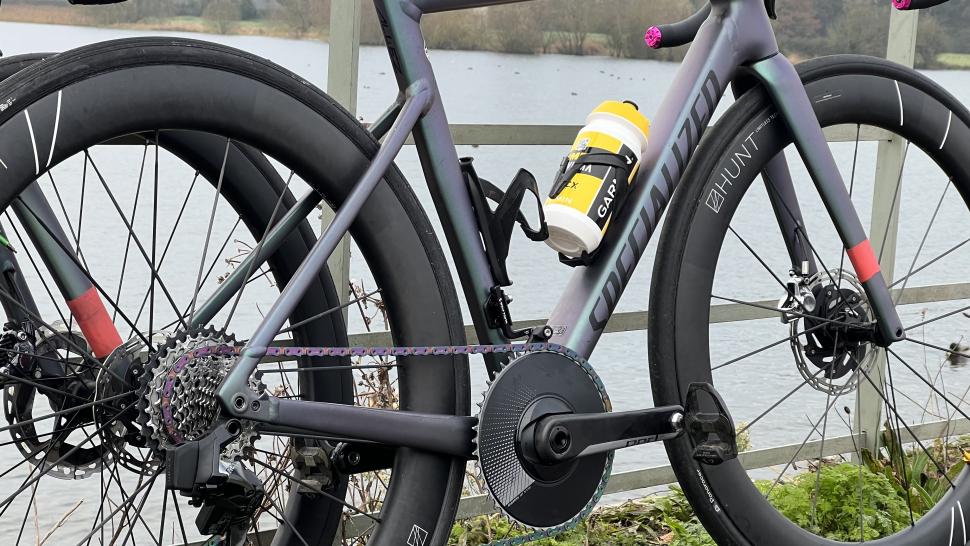

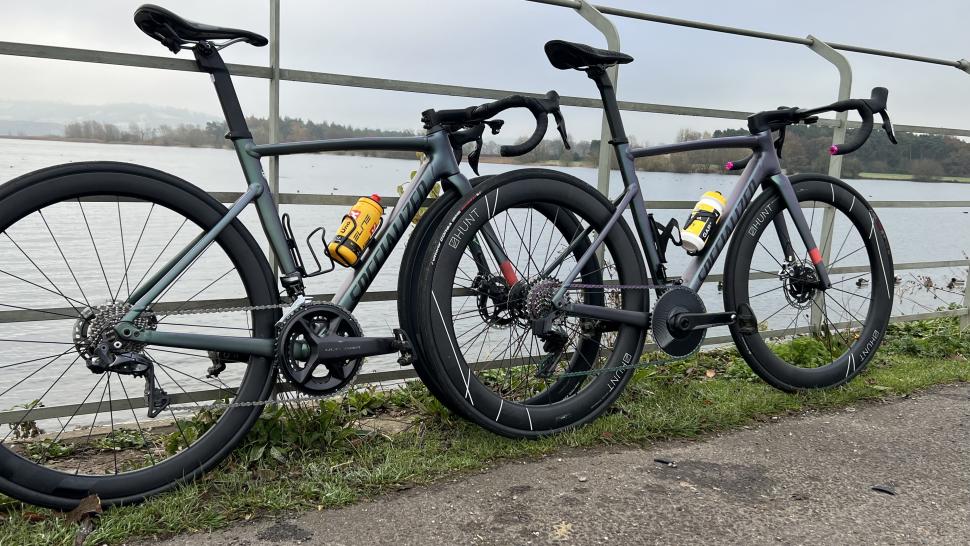

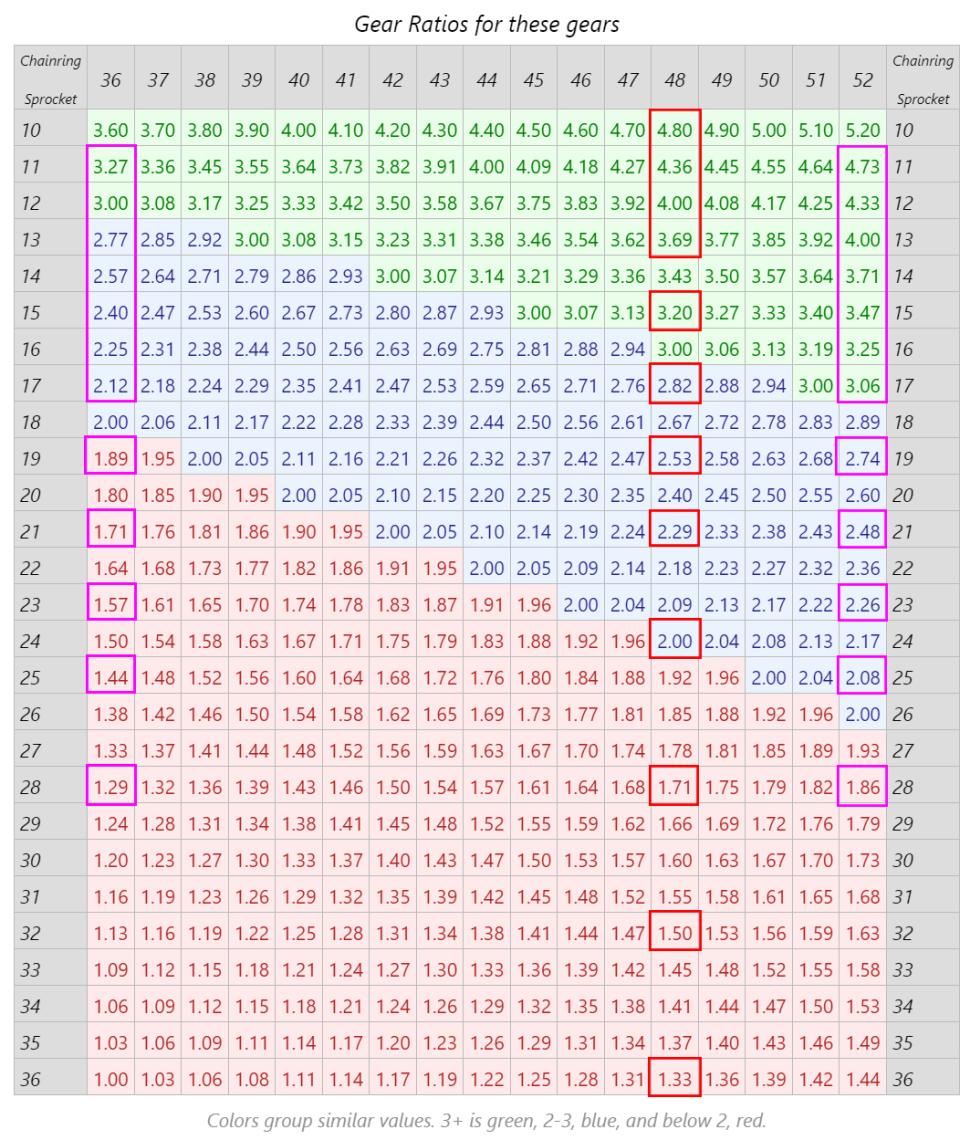

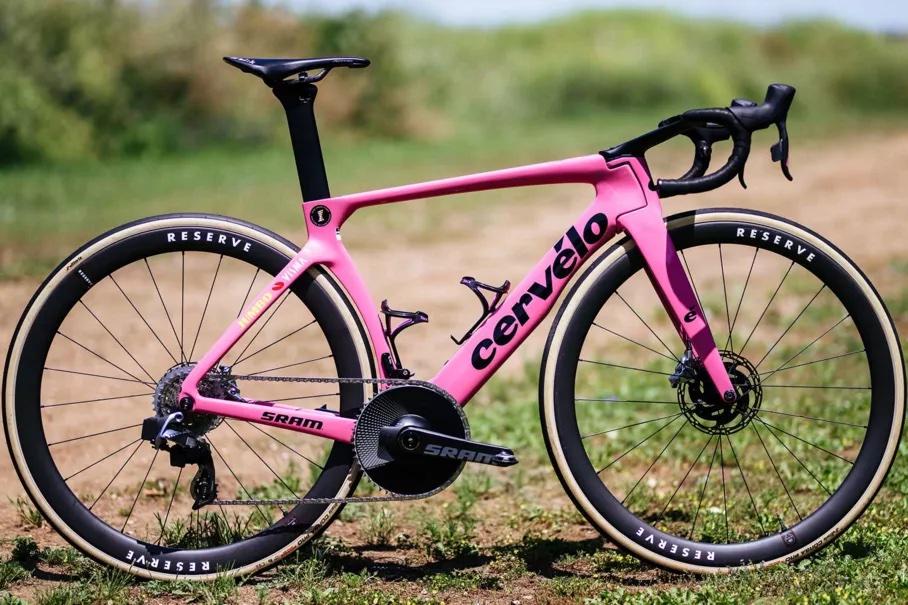
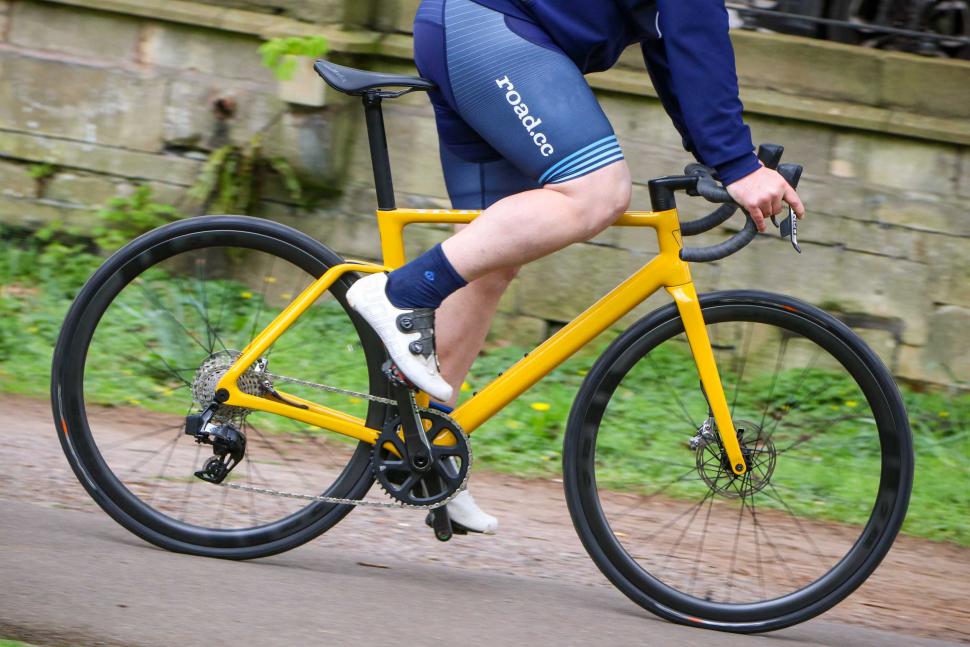
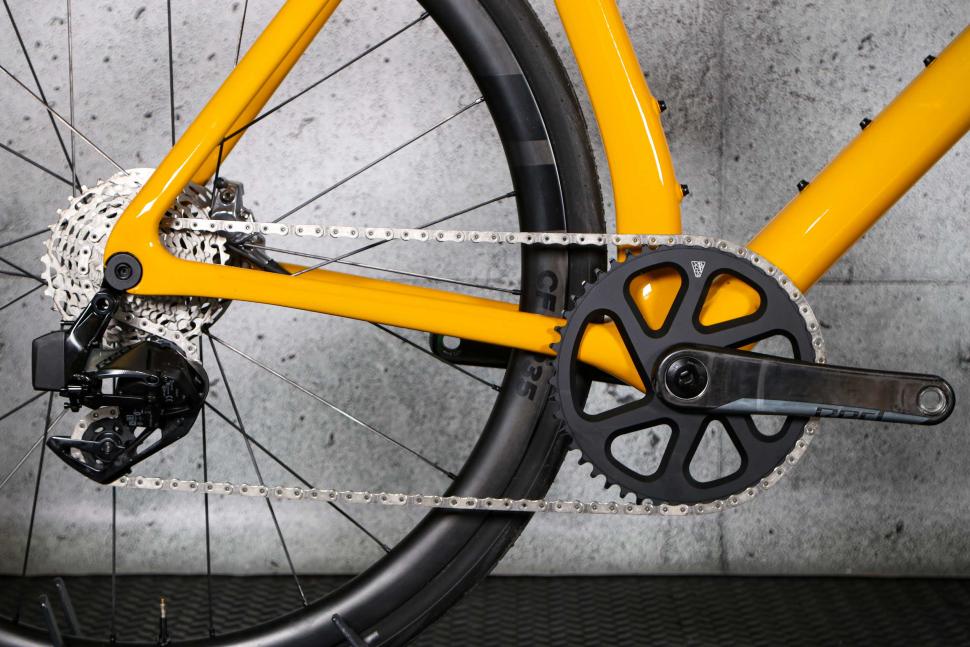


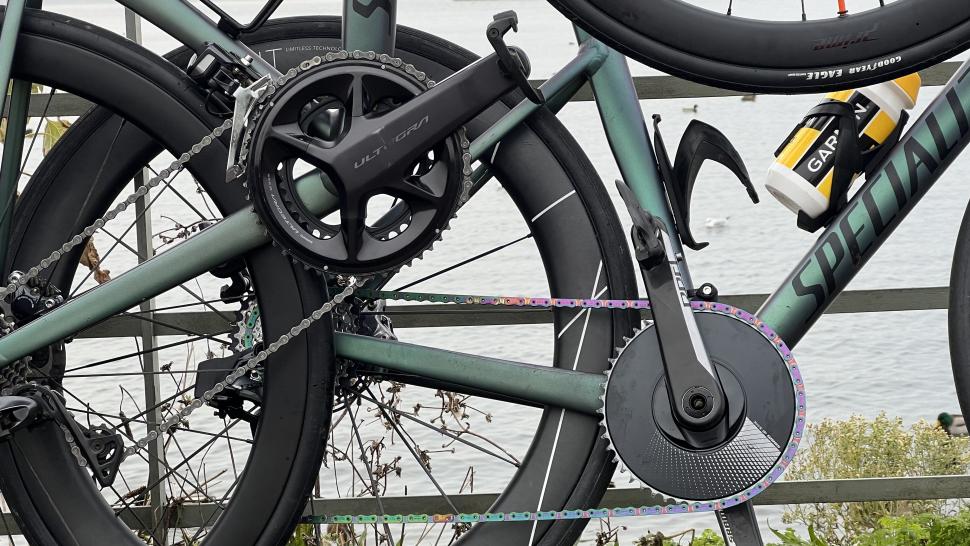
Add new comment
70 comments
You guys keep talking about changing the chain ring size or changing the tyre size or the wheel size, I've no doubt that would change the equation, I am simply saying that for the figures that Jamie has given regarding his chainring and cassette he has a range of 3.47 and for the figures he has given for Tom's chainrings and cassette Tom has a range of 3.44. It really is as simple as that, 3.47 is bigger than 3.44. I simply cannot see how you can argue differently (no oh if you change the chainrings or the wheels or the cassette, just tell me how 3.47 is smaller than 3.44!).
Jamie, you started this, your thoughts?
What we're trying to say is that subtracting one number from another is not the way to measure gear range because the only way it means anything to the cyclist is as a ratio, that is why there is always a division involved, all those numbers on the table are the chainring size divided by the sprocket size, you cannot use subtraction to compare them, when I suggested reducing the chainring size and increasing the wheel size I did that to change the subtraction number you want to use without changing the gear for the cyclist and that is what we are discussing at the end of the day.
And once again the gap between Jamie's highest ratio and lowest ratio is bigger than the gap between Tom's highest ratio and lowest ratio and therefore he has a wider range. 3.47 is bigger than 3.44!
The numbers are not comparable, you might as well be saying 3.47cm is bigger than 3.44 inches. You're stuck on the particular numbers that Jamie has provided without looking at what they represent. If a cyclist comes up to you and says they have a top gear of 4.80, what does that actually mean and how does it feel when you are riding the bike? Go back to first principles and work out how gears are calculated and think about how that feels when you are riding a bike, what matters and why does it matter.
It means that for every full revolution of the pedals, the wheel revolves 4.8 times. Jamie has a choice between a top gear that does this and a bottom gear that means for every full revolution of the pedals the wheel revolves 1.33 times. Tom's top gear makes the wheel revolve 4.73 times and his bottom gear makes the wheel revolve 1.29 times per full revolution of the pedals. Jamie has a wider gap (or range) between the most number of wheel revolutions he can get per pedal revolution and the least number he can get per pedal revolution at 3.47 compared to Tom's gap of 3.44. Ergo, Jamie has a wider range.
Is what matters to you as a cyclist how many times the wheels turns with each pedal rev or how far you travel for each pedal rev? Obviously it is how far you go with each pedal rev. Ergo, you don't know whether Jamie or Tom has a wider range because you don't know what their wheel and tyre setup is. Ergo, changing wheel or tyre size affects total gear range in the same way chainging the spread of a cassette affects total gear range. Or ignore that and ergo an old school racer with 52/42 rings and a 12-21 cassette has a wider gear range than an Eagle 28t, 10-52 equipped MTB.
These are all direct consequences of your logic and none of them make any sense.
No - You tell me how 3.6x is bigger than 3.67x? I have explained to you at length why those are the number that matters. There is no reason for me to address your numbers unless you explain why those are the ones that really matter.
Now, think what you're saying in your first sentence - if you change the tyre size on a bike it changes how wide its gear range is in the same way that changing cassette size would. Seriously? You're happy with that explanation? It doesn't make you think something strange is going on with your thought pattern?
This is simply because the meaning you ascribe to gear range is flawed. What matters in the real world is how many times faster your top gear is than your low gear. Jamie can go 3.6 times faster, Tom can go 3.67 times faster. Why is this the right way to look at gear range? On my MTB I have a 10-52 cassette and 28t chainring. I think this is a massive gear range because I can go 5.2 times faster at one end of the cassette than the other. You think it is a small gear range because they are only 2.26 ratio points away from each other. Who is correct? Obviously I am* - it is a massive gear range. If you disagree then you have never ridden a modern 1x12 MTB drivetrain. If you do go and ride one you will realise what an utter nonsense it is to claim that the gear range is small.
That's a real groupset - what about a fictional one at the other end of the speed range? What if we had a groupset aimed at land speed record bikes. What if the range of ratios went from 21.33 to 24.9? Would anyone in their right mind call this the widest range set of gear ratios we're currently discussing? Is a set of gears that works at, say, 110 to 140mph for a set cadence a wider range than a set of gears that works from 10 to 38mph? No, it isn't - not if you want the comparison to make any sense or be remotely useful for any purpose.
BTW - by your logic you don't even know whether Jamie or Tom has the widest range groupset, because again in your way of thinking total wheel diameter also affects how big the gear range is. If Jamie had road tyres and Tom had gravel tyres, Tom would have the widest gear range according to you in terms of speed at cadence. Switch it around and now Jamie has the widest gear range in terms of speed at cadence - even though the gears themselves haven't changed! Does that make sense to you? Is it a useful way to think about gears?
* NB, it's not just me. The entire cycling industry talks about gear range in this way... because it is actually logically consistent, useful and makes sense.
So, explain to me how you would do that? Sorry, trick question, you can't. You could give Tom a 1t bigger chainring at each end, and guess what happens?
This ties into 'what do we mean by gear range?' Do we want it to refer to things we can actually do to a bike, or do we want it to refer to numbers we can only create through an abstract mathematical exercise and have no direct relevance to riding without running through another process (wheel size) which might change the results all over again? I think the former makes more sense.... don't you?
I think the clue is in the name "gear ratios"
To be pedantic, Jamie's range is exactly 360% as that is the range of his cassette, the 361 figure appears because the table only gives the values to 3 significant figures.
Hah! Good spot!
Is the basic question of gear hardness/easiness here not equally expressed as "how far will the bike go each time I pedal it?"
If so, putting the two set-ups" details (700c wheels, 28mm tyres) into bikecalc's metric development spreadsheet gives:
1x - 10.22m high gear, 2.84m low. A 7.38m difference
2x - 10.07m high gear, 2.74m low. A 7.33m difference
So the 1x is harder at both ends (fnar), as one revolution of the cranks sends the bike further. But the difference between the high-gear/low-gear distances travelled is also bigger for the 1x set-up. That difference can only really be described as a "range", and as that range details "how far your bike goes each time you pedal" it would seem to be a range that is meaningful for cyclists to measure.
I do also get that the relative importance of each 1cm extra decreases as the distance increases (ie the gear gets harder), and perhaps that's where the two approaches here differ. But the one I've set out doesn't seem wrong either mathematically or as a matter of language, so I don't think Jamie's original claim was wrong either.
Yes - but when talking about gear ratios, does it make sense to say the widest range is the biggest absolute change between top and bottom gear, or the biggest ratio of top and bottom?
To put it another way, does it make sense to say you can change how wide your gear range is simply by changing the tyre size on your bike? As a matter of language, I don't think it does (and neither does the rest of the bike industry).
If we're talking about gear ratios, sure. But if we're talking about "how far does my bike go when I pedal it", then the size of the wheel/tyre does matter and you can change the range of how far a bike goes when you pedal it by changing them.
Like the vast majority of cyclists, I'm not part of the bike industry. I find "how far does my bike go when I pedal it" is a valid metric for my cycling, and so I don't think a measurement of that range should be described as "wrong" just because it doesn't produce the same result as a measurement of the range of gear ratios. What's useful for the bike industry isn't necessarily useful for an individual cyclist.
Right, but to me, you're talking about two different things, and it does not make sense to conflate them.
Using your metric, if someone on a 1x system said they wanted a wider gear range you could just give them a bigger chainring. Or if they said they wanted the 1x system they have to go faster, you can also give them a bigger chainring. But did those two people want the same thing? Unlikely.
Worth noting that the original context of the comment was the question of whether the 1x would have a wide enough range to cope with a hilly ride with lots of steep climbing. Well again, by your metric you can give him a wider range by putting on a bigger chainring. Is that going to help? No. Is it likely then that this is what he was trying to describe with the word 'range'? No. As a matter of language, you have created a significant point of confusion that need not exist.
My 2 penn'orth.
I did quite a good empirical test this year in that I borrowed a 1x 12 speed SRAM gravel bike from LBS and went out on a fairly long (70 mile), fastish (19mph average) ride with my local club. I found I was quite often searching for the right gear, especially on a hill tbh, and that's riding the N Somerset area with lots of hills but nothing long or supersteep.
I then bought said bike but set it up for road with 2x Shimano 12 speed. Much better result. I use it as my winter bike, no problem at all.
50/39/30 is the right answer...... paired with a cassette for where you ride and you'll go anywhere.....
Personally.... I ride 50/34 - 13/30 on my Campy equipped road bikes on 28's.... and on my custom gravel bike 46/33 and 11/36 Sram with 42's rubber.... with the bike packing option depending on area to go 46/30 up front
Those sound like my perfect ratios, although I do occasionally dabble with the 11t on my road bike.
48/31 and 11-34 on the gravel bike, I always end up either inner ring and quite far down the casstte, or big ring but quite far up the cassette! 🙄
46/33 and 11-36 would probably be the ideal range but not if it means changing the entire drivetrain from Shimano to SRAM, expensive!
Agreed; the chainring ratios on GRX are wrong, the big is too big and the small is too small. Change the inner to a 34.
One in every crowd, a triple guy. Oh, heck, now that I understand how you use those things I will never try to convince you to do otherwise. You help us stay sane. Ride on!
I always wonder if the real reason that SRAM are so keen to promote 1x for road bikes is that they're just not very good at making reliable front mechs.
Really it's a daft question because it depends so much on what you're doing. I'm very happy with 1x on my mtb but I'm also very happy with 2x on my road bike.
50-34*11-34 is a great range for the road IMHO. (Except on the Fred obviously when really low is not low enough).
Although I've become very adept at adjusting doubletap front mechs (and avoiding the situation that causes chain-drops), I won't argue with anyone who wants to give up on them. I've been doubletapping for 11 years and I have no plans to give up.
This is all going to depend on the combination of rider, terrain and load. I'm older, tubbier and less fitter than I'd like to be with hills 20%+, some of them on grass (bridleway). I've found a range of 750% is about right, but most of the time the middle 400% works fine. The solution for me is a triple with most time spent in the middle ring; 1x plus if you will. I've tried wide range 2x but the front shifts need care (especially with load), the gap is large (46/26) and more front shifting is needed than with 3x.
If I move somewhere flatter then 1x would work. I'd remove large and small rings from the triple and the front shift system, no cost involved.
Eh... I think Dylan Johnson and Silca had something to say about this on a recent podcast, yeah being in the bigger ring on the front helps but if you want any sort of decent range on a 1x system you end up with 9 or 10 tooth sprockets at the back where you quickly lose efficiency. EDIT: I guess they did say 'on a climbing day' but how many of us have a specific drivetrain just for climbing days?
single front ring and biggest sprocket is more cross chained than an inner chainring on the same biggest sprocket, so in your lowest gear on a 1x setup you're more cross chained than in your lowest gear on a 2x setup? I don't know about all the in-between gears though so not sure how much time on average would be spent at the same degree of cross chaining on each setup.
I think I'm coming around to 1x on my gravel bike, 2x GRX seems compromised by weird ratios where I'm always changing between inner and outer chainrings, which gets boring.
BUT 1x always seems noisier and seems to go out of adjustment quicker than a 2x setup, my theory is just a bigger mech trying to wrap around a bigger cassette is always going to be under more tension and more prone to knocks etc. Would drive me crazy on my 'good' road bike hearing it rumbling away in the lowest gear when wicnhing up a long climb etc. I think 2x in theory should always be quieter and smoother running because you are asking less of the derailleurs.
A climbing day is exactly when you need the 9/10 tooth sprockets, otherwise you're just going to freewheel down the hills.
McCarthy says there’s “no difference between 1x and 2x chain and cassette wear”,
I'm surprised about this. Some of the benefits of a 2x set-up is that you can maintain a better chainline most of the time, there is less chance of the chain coming off because of the cage on either side and the chainring on the other, and that if the chain does comes off you can get it back on without getting your hands dirty. A 1x will have a worse chainline at either end of the cassette than a 2x, and will invariably need a guide to stop the chain coming off the front.
I agree, it is very surprising to be told that.
You will inevitably spend more time in compromised chainlines on a 1x than a 2x... well if you are riding in mixed terrain. That chain cross over is likely to cause additional friction, which in turn will cause wear.
But where wear is most relevant for me is the chainring. Inevitably a smaller ring wears faster than a bigger ring as angles are greater and load shared across less teeth. Add to that, a smaller ring will require more time towards the bottom of the cassette on the flat / downhill, increasing chain cross over and increased friction / wear.
I was incredibly frustrated by the chainring wear on my Ekar groupset, and was relieved to go 2x on my gravel bike. Would not go back.
I ride a hybrid, not a road bike, and I'm a utility cyclist and commuter rather than a recreationalist or a roadie. My bike has triple chainrings, but I almost never use any ring other than the middle one. I could almost certainly cope with a 1x setup...
Marketing fad.
(And downtube shifters do have many advantages.)
I put Campag Ekar on a bike for this year and I've done a lot of road riding on it. Ekar is 1x13 and I have it set up as 40 x 9-42. It works very well for road. I could maybe do with an intermediate sprocket for riding at about 30kph but that's being really picky. For me 1x is not a revolutionary advance but it's pleasingly uncomplicated and makes washing your bike around the BB much easier!
Pages